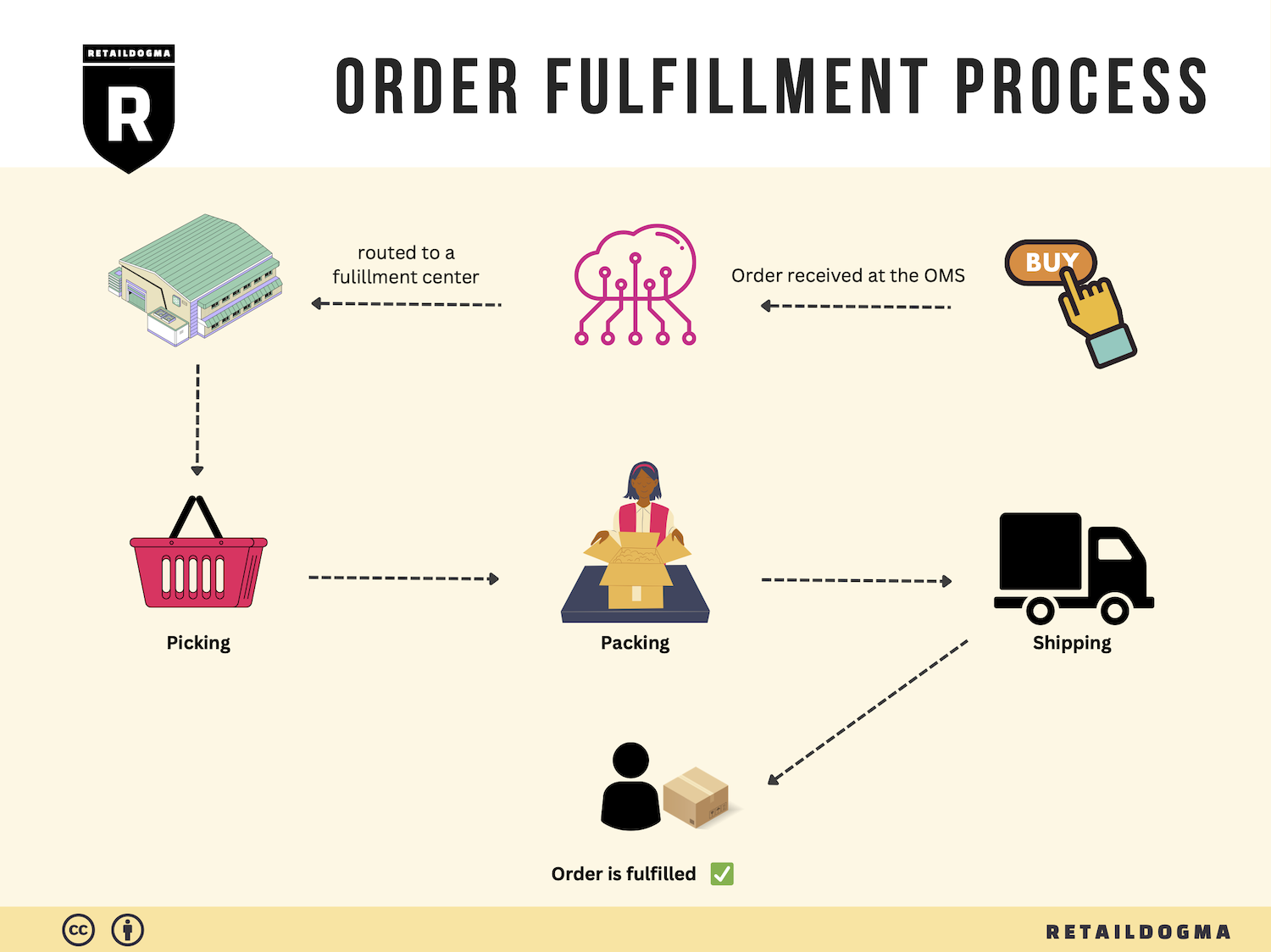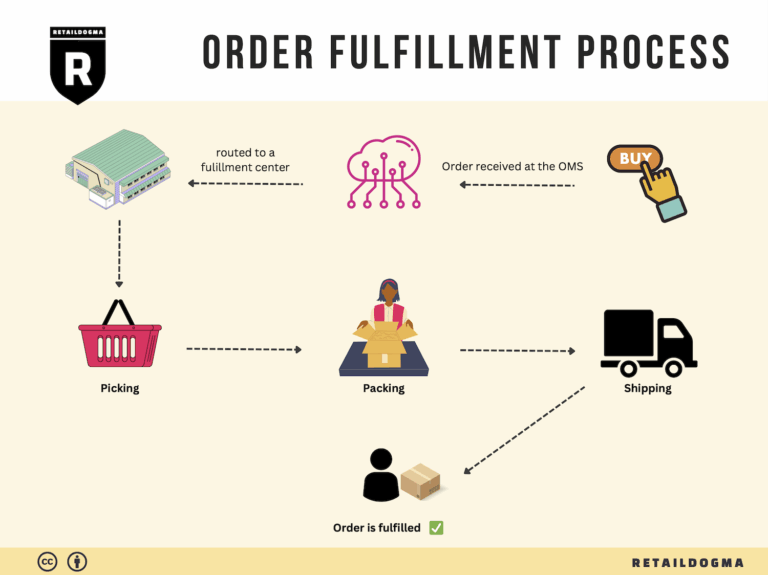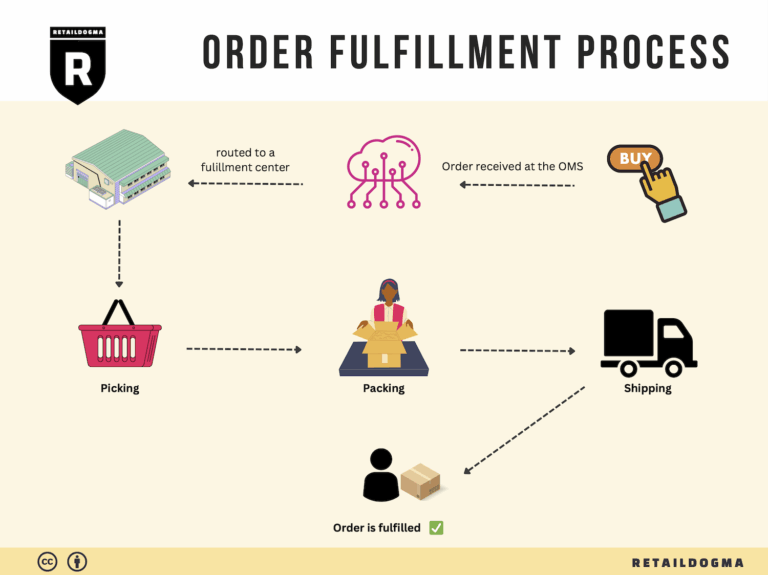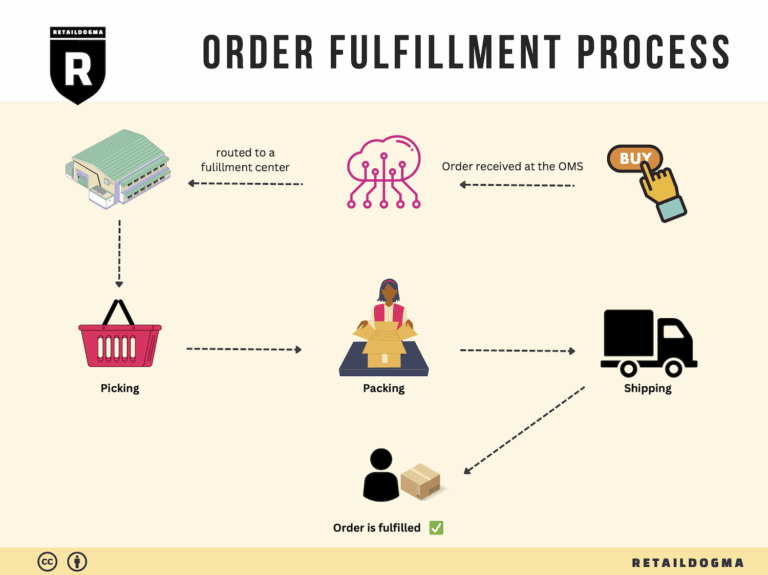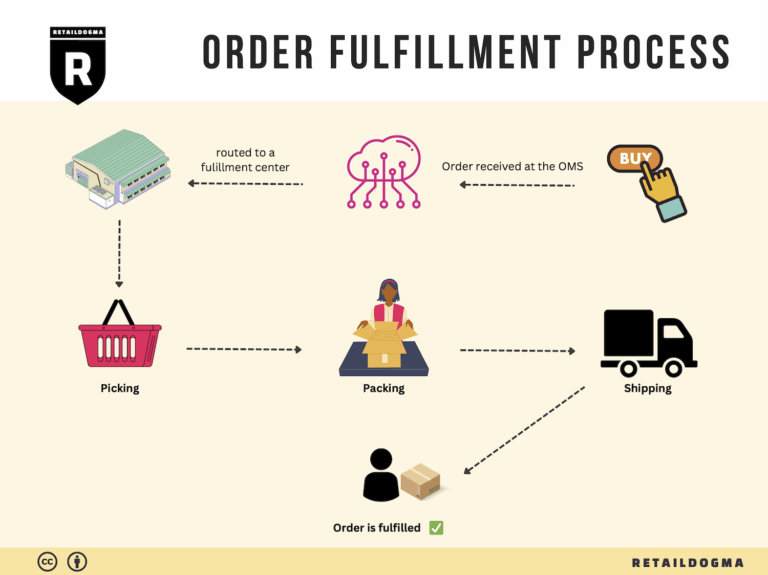How Order Fulfillment Works: A Step-by-Step Guide for Businesses
What is E-commerce Fulfillment? An Introduction for Growing Businesses
As e-commerce businesses expand, many owners find themselves grappling with the complexities of packing and shipping orders. This can quickly become a significant pain point, consuming valuable time and resources that could be better spent on growth strategies, product development, or customer engagement. The process of getting a product from your warehouse to your customer’s doorstep is known as fulfillment, and it encompasses everything from inventory management to shipping logistics.
Understanding E-commerce Fulfillment
E-commerce fulfillment refers to the entire process of receiving, processing, and delivering customer orders. It begins when a customer places an order and concludes when the product is successfully delivered to them. For growing businesses, navigating this process can be daunting, especially when trying to maintain high levels of customer satisfaction while managing operational efficiency.
In this guide, we will explore the various models of fulfillment, including third-party logistics (3PL) and Fulfilled by Amazon (FBA). Each model has its own advantages and drawbacks, making it crucial for business owners to understand which option aligns best with their operational needs and customer expectations.
Core Services of Fulfillment
At its core, fulfillment includes several essential services:
– Inventory Management: Keeping track of stock levels to avoid overstocking or stockouts.
– Picking and Packing: Accurately selecting products from inventory and preparing them for shipment.
– Shipping: Managing the logistics of getting products to customers, including carrier selection and tracking.
– Returns Management: Handling product returns efficiently to maintain customer satisfaction and manage inventory levels.
Choosing the Right Fulfillment Partner
Choosing the right fulfillment partner can significantly impact your business’s efficiency and customer satisfaction. In this guide, we will provide practical tips on evaluating potential partners based on criteria such as scalability, service offerings, pricing structures, and customer service capabilities.
Pricing Considerations
Understanding the pricing models associated with fulfillment services is essential for budgeting and financial planning. This guide will break down common pricing structures, including per-order fees, storage fees, and shipping costs, helping you to make informed decisions.
Empowering Your Logistics Decisions
Ultimately, this guide aims to empower e-commerce businesses to navigate the complexities of logistics and fulfillment confidently. By understanding the various models, core services, and evaluation criteria for potential partners, you will be equipped to make strategic decisions that enhance your operational efficiency and drive growth. Whether you are a startup or an established player in the market, effective fulfillment is the backbone of your customer experience and, by extension, your business success.
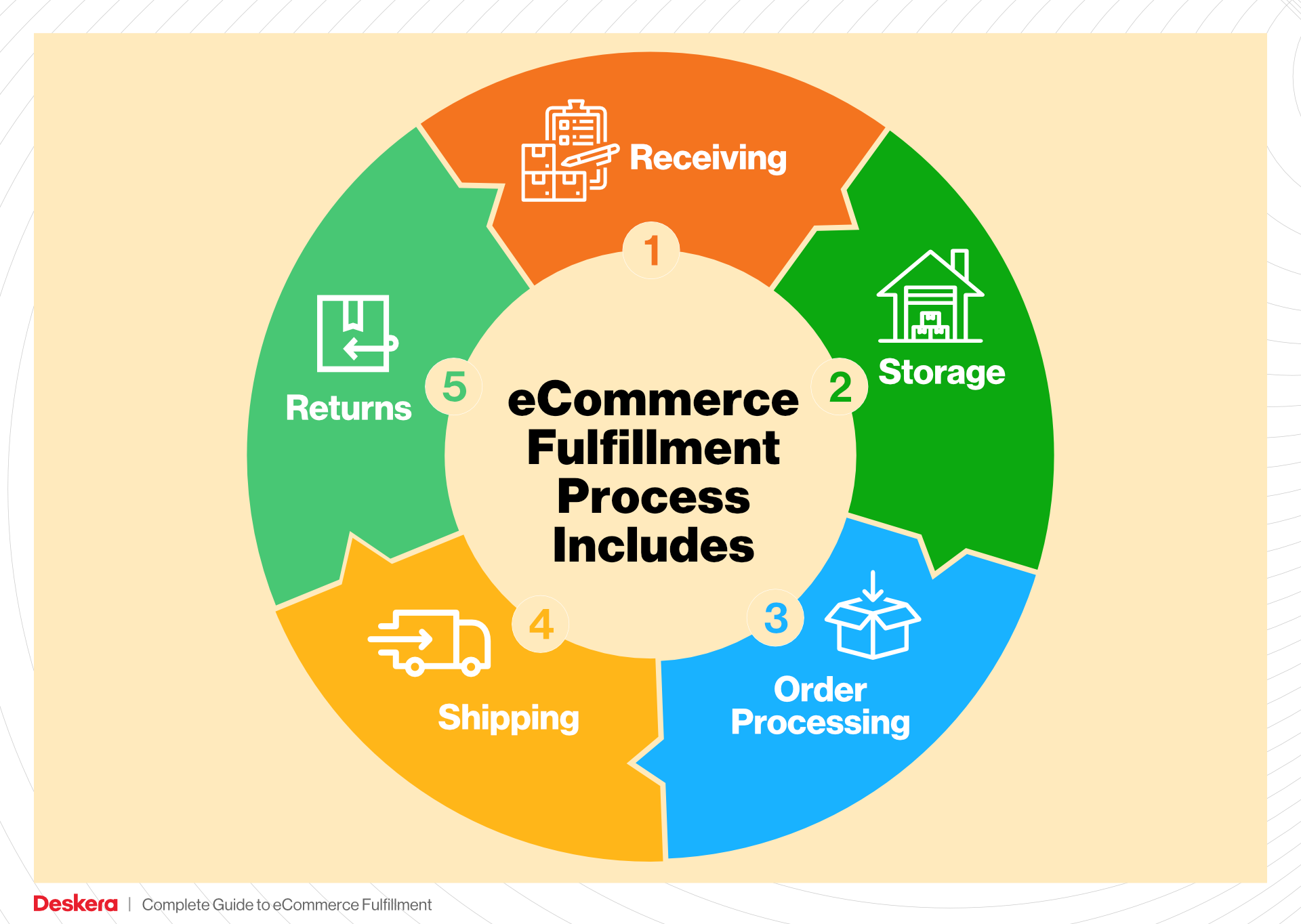
What You’ll Learn In This Guide
- What is E-commerce Fulfillment? An Introduction for Growing Businesses
- The Order Fulfillment Process: From ‘Buy’ Button to Customer’s Door
- Comparing Fulfillment Models: In-House vs. 3PL vs. Dropshipping
- A Deep Dive into Amazon FBA: Pros, Cons, and Who It’s For
- Core Services Offered by Fulfillment Centers
- How to Choose a Fulfillment Partner: A 6-Point Checklist
- Understanding Fulfillment Pricing: A Breakdown of Common Fees
- Frequently Asked Questions (FAQs) about Fulfillment
- Conclusion: Is Outsourcing Fulfillment the Right Move for Your Business?
- Important Disclaimer
The Order Fulfillment Process: From ‘Buy’ Button to Customer’s Door
1. Receiving Inventory
The order fulfillment process begins with receiving inventory from suppliers. When products arrive at the fulfillment center, they are checked against purchase orders to ensure accuracy in quantity and quality. This process typically involves scanning items to record their SKUs (Stock Keeping Units) into the inventory management system.
Importance: Accurate receiving is crucial as it sets the foundation for the entire fulfillment process. Any discrepancies at this stage can lead to stockouts or excess inventory, which can negatively affect sales and operational efficiency.
Key Term: SKU (Stock Keeping Unit) – A unique identifier for each distinct product and service that can be purchased. Proper management of SKUs is vital for tracking inventory levels and sales trends.
2. Warehouse Storage
Once the inventory is received and recorded, it is stored in the fulfillment center. Efficient warehouse storage involves organizing products in a manner that optimizes space and facilitates easy access. This may include categorizing items by type, size, or sales velocity.
Importance: Proper storage minimizes the time spent locating products, thereby speeding up the order fulfillment process. It also helps prevent damage to products and reduces the risk of inventory loss.
Key Term: ABC Analysis – A method of classifying inventory based on importance, where ‘A’ items are high-value or fast-moving products, ‘B’ items are moderate, and ‘C’ items are low-value or slow-moving. This approach allows for more efficient space allocation and inventory management.
3. Order Picking
When a customer places an order, the next step is order picking, where items are selected from the warehouse to fulfill the order. Warehouse staff often use pick lists—documents that indicate which items to retrieve and their locations within the storage area.
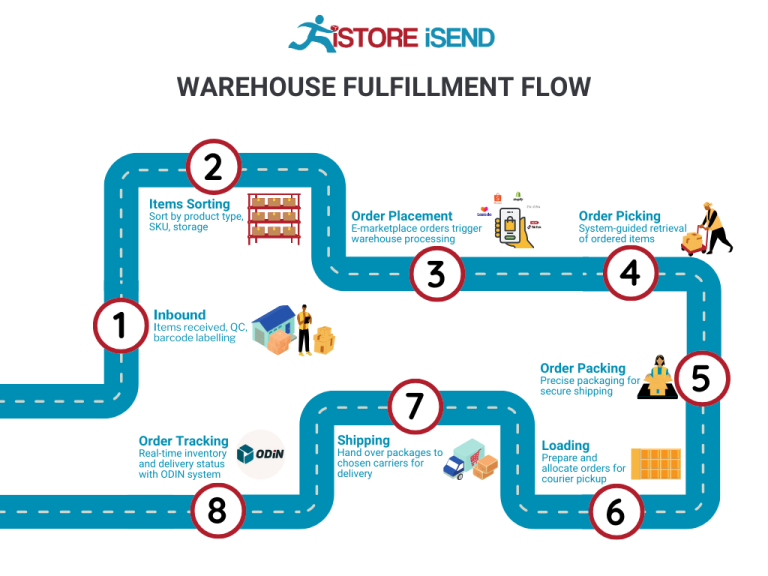
Importance: Efficient picking is critical for meeting customer expectations regarding delivery speed. A well-organized picking process can significantly reduce the time taken to assemble orders, thereby improving overall operational efficiency.
Key Term: Pick List – A document or digital tool that guides warehouse staff in selecting the correct items for an order. It typically includes product SKUs, descriptions, and locations within the warehouse.
4. Order Packing
After items have been picked, they move to the packing station, where they are prepared for shipment. During this phase, products are carefully packed to prevent damage during transit. This includes choosing appropriate packaging materials, labeling, and including any necessary documentation such as invoices or return instructions.
Importance: Effective packing not only protects products but also enhances the customer experience. A well-presented package can create a memorable unboxing experience, encouraging repeat business and positive reviews.
Key Term: Branded Packaging – Custom packaging that reflects a company’s brand identity. This can include custom boxes, labels, and inserts that enhance the customer experience and promote brand recognition.
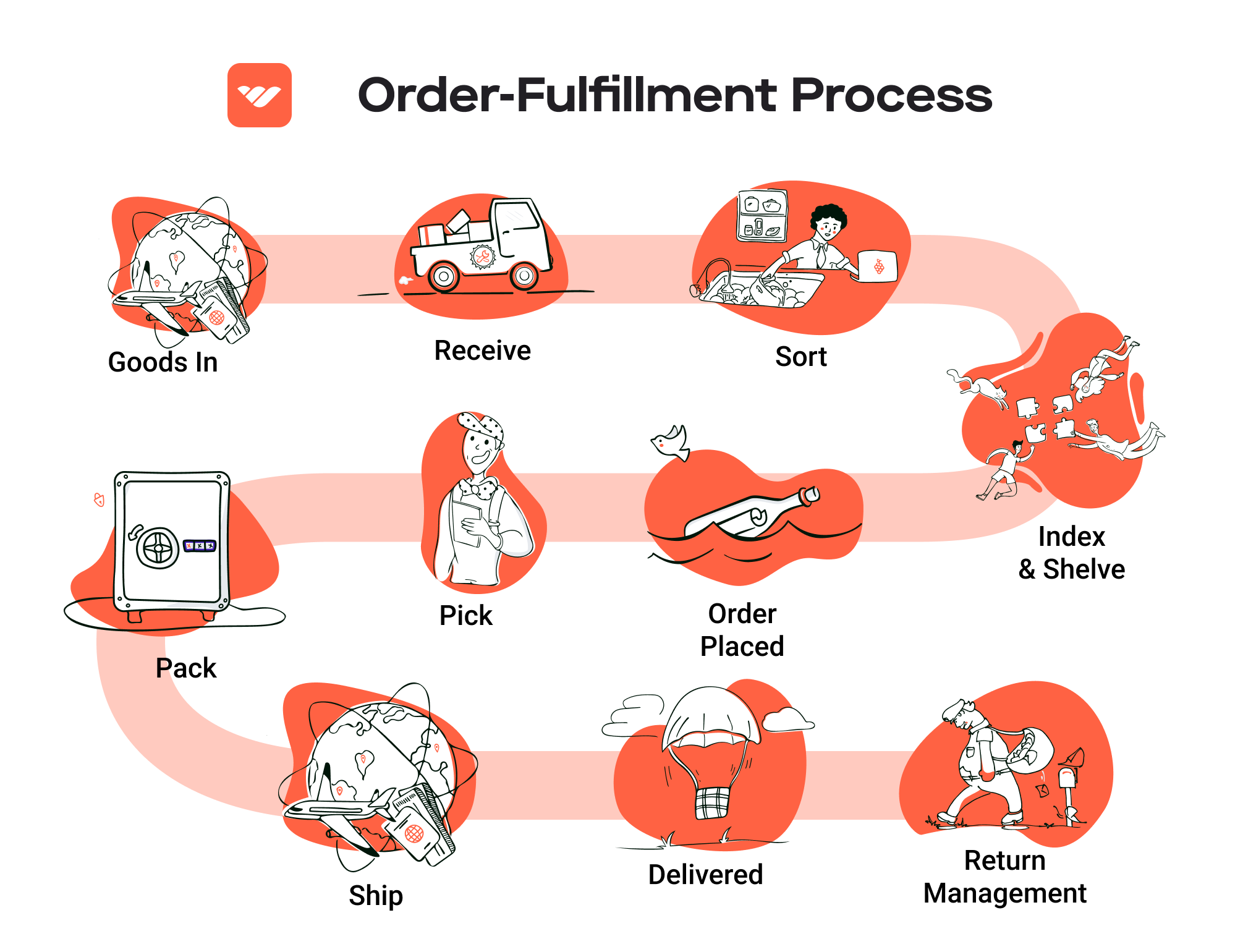
5. Shipping & Delivery
The final step in the order fulfillment process is shipping and delivery. Once packages are packed, they are handed over to shipping carriers for delivery. It’s essential to choose reliable shipping partners to ensure timely and safe delivery. Real-time tracking systems are often employed to keep both the business and the customer informed about the order’s status.
Importance: Timely delivery is a key component of customer satisfaction. A reliable shipping process can differentiate your business from competitors and foster customer loyalty.
Key Term: Carrier Management – The process of selecting and managing relationships with shipping carriers. Effective carrier management can lead to lower shipping costs and improved delivery times, directly impacting customer satisfaction and operational efficiency.
In summary, mastering the order fulfillment process is essential for e-commerce businesses aiming to scale effectively. By focusing on each step—from receiving inventory to shipping and delivery—business owners can streamline operations, reduce costs, and ultimately enhance customer satisfaction.
Comparing Fulfillment Models: In-House vs. 3PL vs. Dropshipping
Fulfillment Model Comparison
| Model | Who Handles Inventory | Best For (Business Stage) | Key Advantage | Key Disadvantage |
|---|---|---|---|---|
| In-House Fulfillment | Business Owns Inventory | Established businesses with stable demand | Full control over operations and branding | High overhead costs and scalability challenges |
| Third-Party Logistics (3PL) | 3PL Provider | Startups to medium-sized businesses | Cost-effective and scalable solutions | Less control over inventory and fulfillment processes |
| Dropshipping | Supplier | New businesses or those testing markets | Low upfront costs and no inventory risk | Lower profit margins and less brand control |
In-House Fulfillment
In-house fulfillment refers to managing the entire logistics process internally, from inventory storage to picking, packing, and shipping. This model is often adopted by established businesses that have a stable demand for their products and sufficient resources to handle logistics operations. The primary advantage of in-house fulfillment is the complete control it offers over the entire process. Businesses can customize their packaging, ensure quality control, and create a unique unboxing experience that reflects their brand identity. However, this model comes with significant challenges. The overhead costs can be substantial, as businesses need to invest in warehousing, staffing, and technology. Additionally, scalability can become an issue during peak seasons or unexpected surges in demand, as the existing infrastructure may not support rapid growth without additional investment.
Third-Party Logistics (3PL)
Third-party logistics (3PL) involves outsourcing logistics operations to a specialized provider. This model is particularly beneficial for startups and medium-sized businesses looking to scale without the burden of managing fulfillment themselves. 3PL providers, such as eFulfillment Service, offer a range of services including warehousing, inventory management, shipping, and returns processing. The key advantage of using a 3PL is cost-effectiveness; businesses can leverage the provider’s expertise and resources, often resulting in lower shipping costs and improved operational efficiency. Moreover, 3PLs are typically equipped to handle fluctuations in demand, making it easier for businesses to scale. However, the downside is that companies may have less control over their inventory and fulfillment processes, which can lead to issues such as miscommunications or errors in order fulfillment. Businesses must choose their 3PL partner carefully to ensure alignment with their operational goals and customer service standards.
Dropshipping
Dropshipping is a fulfillment method where businesses sell products without holding any inventory. Instead, when a customer places an order, the business purchases the item from a supplier who then ships it directly to the customer. This model is particularly appealing for new businesses or entrepreneurs testing the waters in a market, as it requires minimal upfront investment and eliminates the need for warehousing. The primary advantage of dropshipping is the low financial risk; businesses do not have to invest in inventory upfront, making it easier to enter the market. However, dropshipping also presents significant challenges. Profit margins can be lower compared to traditional retail models, as suppliers often charge higher prices for their products. Additionally, businesses have limited control over product quality and shipping times, which can impact customer satisfaction and brand reputation. As such, dropshipping may not be the best long-term strategy for businesses looking to build a strong brand identity and customer loyalty.
Conclusion
Selecting the right fulfillment model is crucial for e-commerce businesses aiming to scale effectively. Each model—In-House Fulfillment, 3PL, and Dropshipping—has its unique advantages and disadvantages that cater to different business stages and operational needs. By carefully evaluating these options and aligning them with their growth strategies, e-commerce business owners can optimize their logistics and enhance customer satisfaction, ultimately leading to sustainable growth.
A Deep Dive into Amazon FBA: Pros, Cons, and Who It’s For
Understanding Fulfillment by Amazon (FBA)
Fulfillment by Amazon (FBA) is a service offered by Amazon that allows sellers to store their products in Amazon’s fulfillment centers. Amazon takes care of storage, packaging, and shipping, as well as customer service and returns for these products. This service has become a popular choice for e-commerce businesses looking to scale their operations efficiently while leveraging Amazon’s extensive logistics network.
How FBA Works
-
Setup: Sellers create an Amazon seller account and enroll in the FBA program. They prepare their products according to Amazon’s guidelines, which include labeling and packaging requirements.
-
Shipping Products to Amazon: Once the products are prepared, sellers ship them to Amazon’s designated fulfillment centers. Amazon provides shipping plans to help sellers determine how to distribute their products across its network.
-
Storage: The products are stored in Amazon’s warehouses until they are sold. Amazon takes care of inventory management, ensuring that stock levels are monitored and replenished as needed.
-
Order Fulfillment: When a customer places an order for a product, Amazon picks, packs, and ships the item directly to the customer. This process is streamlined and typically results in fast shipping times.
-
Customer Service: Amazon handles all aspects of customer service for FBA orders, including inquiries, refunds, and returns. This allows sellers to focus on growing their business rather than managing day-to-day operations.
-
Multi-Channel Fulfillment: Sellers can also use FBA to fulfill orders from other sales channels, such as their own website or other online marketplaces, allowing for a centralized logistics solution.
Pros of Fulfillment by Amazon
-
Prime Eligibility: Products fulfilled through FBA are automatically eligible for Amazon Prime. This can significantly boost sales, as Prime members tend to prefer products that offer free and fast shipping.
-
Customer Trust: Amazon is a trusted brand with a large customer base. When sellers use FBA, their products benefit from Amazon’s reputation, which can lead to increased sales and customer confidence.
-
Multi-Channel Fulfillment: FBA allows sellers to fulfill orders from various sales channels using Amazon’s logistics. This flexibility can streamline operations and reduce the complexity of managing multiple fulfillment methods.
-
Scalability: FBA is designed to grow with your business. As your sales volume increases, Amazon can handle the increased demand without the need for you to invest in additional warehousing or staffing.
-
Simplified Logistics: By outsourcing fulfillment to Amazon, sellers can reduce the time and effort spent on logistics management. This allows them to focus on other critical aspects of their business, such as marketing and product development.
-
Advanced Analytics: FBA provides sellers with access to detailed sales and inventory analytics through the Amazon Seller Central dashboard, allowing for informed decision-making regarding inventory management and sales strategies.
Cons of Fulfillment by Amazon
-
High Fees: While FBA offers many benefits, it comes at a cost. Sellers must pay various fees, including storage fees for inventory and fulfillment fees for each unit sold. These costs can add up, particularly for low-margin products.
-
Strict Inventory Rules: Amazon has stringent inventory management policies. Sellers must adhere to these guidelines, including limits on storage space and requirements for product labeling. Failure to comply can result in additional fees or inventory removal.
-
Commingling Risks: When products are commingled, they are mixed with inventory from other sellers. This can lead to issues such as receiving returns of items that are not yours, potentially affecting your brand’s reputation and customer experience.
-
Less Control Over Fulfillment: By utilizing FBA, sellers relinquish some control over the fulfillment process. This means they may not have the ability to customize packaging or manage the shipping experience, which can be important for brand identity.
-
Dependence on Amazon: Sellers who rely heavily on FBA may find themselves at the mercy of Amazon’s policies and algorithms. Changes to these policies can directly impact sales and fulfillment operations.
-
Long-Term Storage Fees: If inventory does not sell within a specific timeframe, Amazon charges long-term storage fees. This can create pressure to sell products quickly, potentially leading to aggressive discounting strategies.
Who is FBA Best For?
Fulfillment by Amazon is best suited for businesses that:
-
Have High Sales Volume: Companies with significant sales volumes can benefit from the efficiencies of FBA, as the costs associated with fulfillment can be spread across a larger number of orders.
-
Sell Products with Strong Demand: FBA is ideal for sellers of popular and fast-moving products, particularly those that can leverage the Prime membership to boost sales.
-
Seek to Scale Quickly: Startups and established businesses looking to expand their reach rapidly can take advantage of Amazon’s extensive logistics network without the need for significant upfront investments in warehousing and staffing.
-
Desire to Focus on Core Competencies: Businesses that want to concentrate on product development, marketing, and customer engagement rather than logistics will find FBA appealing, as it allows them to outsource fulfillment tasks.
-
Are Comfortable with Amazon’s Ecosystem: Sellers who are already familiar with selling on Amazon and understand the platform’s dynamics are more likely to succeed with FBA.
In conclusion, while FBA offers numerous advantages, such as increased visibility, customer trust, and streamlined logistics, it is essential for sellers to weigh these benefits against the potential drawbacks, including fees and loss of control over fulfillment. By understanding both the pros and cons, e-commerce business owners can make informed decisions about whether FBA aligns with their growth strategies and operational needs.
Core Services Offered by Fulfillment Centers
Inventory Management & Warehousing
Effective inventory management is foundational for any e-commerce business aiming to scale efficiently. Fulfillment centers provide robust inventory management systems that offer real-time tracking of stock levels, helping businesses avoid the pitfalls of overstocking or stockouts. These systems often integrate seamlessly with various e-commerce platforms, allowing business owners to monitor their inventory from anywhere, at any time.
By utilizing a fulfillment center’s warehousing capabilities, e-commerce businesses can store their products in secure, strategically located facilities. This not only reduces overhead costs associated with maintaining their own storage but also optimizes shipping times to customers. Moreover, fulfillment centers typically offer flexible storage options without long-term contracts or minimum order requirements, allowing businesses to scale their operations according to demand fluctuations.
The benefits of efficient inventory management and warehousing are multifaceted. Businesses can improve cash flow by reducing excess inventory costs, enhance customer satisfaction through timely deliveries, and focus their resources on strategic growth initiatives rather than logistical challenges.
Pick and Pack Services
Pick and pack services are essential for e-commerce businesses that require efficiency and accuracy in order fulfillment. This process involves selecting the correct items from inventory (picking) and then packaging them appropriately for shipping (packing). Fulfillment centers employ trained staff and utilize advanced technology to ensure that each order is picked accurately and packed securely, minimizing the risk of errors.
The primary advantage of utilizing a fulfillment center’s pick and pack services is the significant reduction in order processing time. Faster processing leads to quicker shipping, which can enhance customer satisfaction and loyalty. Additionally, fulfillment centers often implement quality control measures to ensure that the right products are shipped, reducing the incidence of returns and boosting the overall customer experience.
For e-commerce businesses, partnering with a fulfillment center for pick and pack services translates into more efficient operations. It allows businesses to scale their order volumes without sacrificing accuracy or speed, ultimately leading to increased sales and improved brand reputation.
Kitting and Assembly
Kitting and assembly services offered by fulfillment centers enable e-commerce businesses to package multiple items together as a single unit, often enhancing the customer experience through bundled offerings. This service is particularly beneficial for businesses that sell products that are frequently purchased together or for subscription box services that require unique combinations of products.
The kitting process involves assembling various products into a single kit, which is then packaged and shipped as one unit. This can include anything from creating gift sets to assembling complex products that require multiple components. By outsourcing kitting and assembly to a fulfillment center, e-commerce businesses can save valuable time and resources that would otherwise be spent managing these processes in-house.
The benefits of kitting and assembly are substantial. It allows businesses to streamline their operations, reduce handling costs, and enhance product appeal by offering curated packages. Additionally, this service can lead to increased average order values, as customers may be more inclined to purchase bundled products.
Returns Management (Reverse Logistics)
Returns management, often referred to as reverse logistics, is a critical service provided by fulfillment centers that can significantly impact customer satisfaction and operational efficiency. The returns process involves handling items that customers send back, which includes receiving the returned products, inspecting them, restocking them, and managing any necessary repairs or refurbishments.
A well-managed returns process is essential for e-commerce businesses, as it directly affects customer trust and future purchasing decisions. Fulfillment centers streamline this process by providing comprehensive returns management services that ensure quick and efficient handling of returns. This can include automated return authorizations, easy-to-print return labels, and real-time tracking of returned items.
The benefits of effective returns management are profound. It enhances the overall customer experience by making the returns process simple and hassle-free, thereby increasing the likelihood of repeat purchases. Additionally, it helps businesses maintain accurate inventory levels and improve cash flow by quickly restocking returned items. By outsourcing returns management to a fulfillment center, e-commerce businesses can focus on growth while ensuring that their customers have a positive experience, even when returning products.
Conclusion
In conclusion, partnering with a fulfillment center provides e-commerce businesses with a suite of core services that are critical for scaling operations effectively. From efficient inventory management and warehousing to streamlined pick and pack services, kitting and assembly, and robust returns management, these services enable businesses to enhance their operational efficiency, improve customer satisfaction, and focus on strategic growth initiatives. As e-commerce continues to evolve, leveraging the expertise of fulfillment centers will be essential for businesses aiming to stay competitive in the market.
How to Choose a Fulfillment Partner: A 6-Point Checklist
Location & Warehouse Network
Importance:
The geographical location of your fulfillment partner’s warehouses can significantly impact shipping times and costs. A partner with strategically located warehouses can help you reach customers faster and reduce shipping expenses, especially for e-commerce businesses aiming for quick delivery.
Questions to Ask:
– Where are your fulfillment centers located, and how do they align with my target market?
– Do you have a plan for expanding your warehouse network as my business grows?
– How do you handle shipping logistics for international orders?
Technology & Integrations
Importance:
In today’s fast-paced e-commerce landscape, seamless technology integration is crucial for efficient operations. A fulfillment partner should have robust software systems that can integrate with your existing e-commerce platforms, enabling real-time inventory management and order tracking.
Questions to Ask:
– What technology do you use for order management and inventory tracking?
– Can your systems integrate with my e-commerce platform (e.g., Shopify, WooCommerce)?
– How do you ensure data security and compliance with industry standards?
Specializations (e.g., Cold Storage, Oversized Items)
Importance:
Different businesses have unique needs based on their product types. If you deal with specialized items, such as perishables that require cold storage or oversized products that need special handling, it’s essential to choose a partner that can accommodate these requirements.
Questions to Ask:
– Do you offer specialized services for my type of products (e.g., cold storage, kitting)?
– What experience do you have in handling products similar to mine?
– How do you ensure compliance with safety and quality standards for specialized items?
Scalability & Capacity
Importance:
As your business grows, so will your fulfillment needs. It’s vital to partner with a fulfillment provider that can scale operations without compromising service quality. Assessing their capacity to handle peak seasons and increased order volumes is essential for sustainable growth.
Questions to Ask:
– What is your current capacity, and how do you manage peak season demands?
– Can you provide examples of how you’ve helped other clients scale their operations?
– What systems do you have in place to forecast and manage inventory levels during growth phases?
Pricing and Contracts
Importance:
Understanding the pricing structure and contractual obligations is critical to maintaining healthy cash flow and profit margins. Transparent pricing with no hidden fees allows for better budgeting and financial planning.
Questions to Ask:
– Can you provide a detailed breakdown of your pricing model (e.g., storage fees, pick and pack fees)?
– Are there any hidden fees I should be aware of?
– What are the terms of your contracts, and is there flexibility for scaling up or down?
Customer Support & Reviews
Importance:
Exceptional customer service can make a significant difference in your fulfillment experience. A partner that prioritizes customer support can help resolve issues quickly and maintain operational efficiency. Additionally, reviewing feedback from other clients can provide insights into the partner’s reliability and performance.
Questions to Ask:
– What level of customer support do you offer (e.g., dedicated account manager, 24/7 support)?
– Can you provide references or case studies from businesses similar to mine?
– How do you handle issues or disputes, and what is your average response time for support inquiries?
Conclusion
Choosing the right fulfillment partner is a critical decision that can significantly impact your e-commerce business’s success. By thoroughly evaluating potential partners using this checklist, you can ensure that you find a provider that aligns with your operational needs and growth aspirations. Take the time to ask the right questions and gather as much information as possible to make an informed choice that will support your business as it scales.
Understanding Fulfillment Pricing: A Breakdown of Common Fees
Initial Setup Fees
When partnering with a fulfillment service, many providers charge an initial setup fee to cover the costs associated with onboarding your business. This fee typically includes the integration of your e-commerce platform with the fulfillment provider’s system, inventory setup, and sometimes, the creation of customized packaging solutions.
The calculation of initial setup fees can vary widely based on the complexity of your needs. For instance, if your business requires a unique inventory management system integration or specialized packing processes, the setup fees could be higher. However, some providers, like eFulfillment Service, may offer free setup to attract small and medium-sized businesses, allowing you to start without significant upfront costs.
Receiving Fees
Receiving fees are charged when your inventory arrives at the fulfillment center. This fee covers the labor and processes involved in unloading, inspecting, and storing your products.
Typically, receiving fees are calculated based on the number of pallets or cartons received. For example, a fulfillment center might charge a flat fee per pallet or a per-unit fee depending on the size and weight of the items. It’s essential to clarify whether the receiving fee includes quality checks and how discrepancies in received versus expected inventory are handled, as these can impact your overall costs.
Storage Fees (per pallet/bin)
Storage fees are ongoing costs associated with keeping your inventory in the fulfillment center. These fees can be charged on a monthly basis and are often calculated per pallet or per bin, depending on how your products are stored.
The rate for storage fees can vary based on factors such as location, the size of your inventory, and the duration of storage. For example, if you are storing large items that take up more space, you might incur higher fees than for smaller items. Additionally, some fulfillment centers may impose long-term storage fees if your products remain in their warehouse beyond a specified time frame. This incentivizes businesses to manage their inventory efficiently and avoid excessive holding costs.
Pick & Pack Fees (per item/order)
Pick and pack fees are charged for the labor involved in retrieving items from storage and preparing them for shipment. This fee is crucial in determining your fulfillment costs, as it directly relates to order volume and complexity.
Pick and pack fees can be structured in various ways. Some providers charge a flat fee per order, while others may charge based on the number of items included in each order. For instance, a fulfillment center may charge a lower fee for orders with fewer items and increase the fee for orders that require multiple picks. Additionally, if your business requires special handling, such as kitting or customized packaging, expect higher pick and pack fees to reflect the additional labor involved.
Shipping Fees
Shipping fees are perhaps the most variable aspect of fulfillment pricing, as they depend on several factors, including the shipping method, destination, package weight, and dimensions. Fulfillment centers often partner with multiple carriers to provide competitive shipping rates, which can benefit your business.
Shipping fees can be calculated in various ways: flat rate, weight-based, or distance-based. Many fulfillment services offer discounted shipping rates through partnerships with carriers, which can significantly reduce costs for your business. It’s essential to discuss shipping options with your fulfillment provider to find the best balance between cost and delivery speed, especially for time-sensitive products.
Tips for Getting an Accurate Quote
When seeking an accurate quote from fulfillment service providers, consider the following tips:
-
Be Transparent: Provide detailed information about your products, order volume, and specific needs. The more your provider knows about your business, the more accurate their quote will be.
-
Ask About All Fees: Inquire about all potential fees, including setup, receiving, storage, pick and pack, and shipping. Ensure you understand how each fee is calculated to avoid surprises later.
-
Consider Growth: Discuss your projected growth with the provider. Some fulfillment services offer scalable solutions that can adjust to your increasing order volumes without incurring excessive costs.
-
Request Multiple Scenarios: Ask for quotes based on different order volumes and product types. This will help you understand how pricing changes with your business needs.
-
Evaluate Value, Not Just Cost: While competitive pricing is essential, consider the overall value of the services offered, including customer support, technology integration, and additional services like returns management.
By following these guidelines, you can ensure a more accurate and comprehensive understanding of fulfillment pricing, allowing you to make informed decisions that align with your business goals.
Frequently Asked Questions (FAQs) about Fulfillment
1. What is order fulfillment?
Order fulfillment is the complete process of receiving, processing, and delivering customer orders. It encompasses inventory management, warehousing, picking and packing orders, shipping, and handling returns. Effective order fulfillment ensures that products reach customers accurately and efficiently, enhancing customer satisfaction and loyalty.
2. What is a 3PL (Third-Party Logistics)?
A Third-Party Logistics (3PL) provider is a company that offers outsourced logistics services, which can include warehousing, inventory management, order fulfillment, and shipping. Businesses partner with 3PLs to leverage their expertise and resources, allowing them to focus on core activities like marketing and product development while ensuring efficient logistics operations.
3. How much do fulfillment services cost?
Fulfillment service costs vary based on several factors, including the size and weight of products, order volume, storage needs, and additional services like kitting or returns management. Typically, costs include a per-order fee, storage fees, and shipping costs. It’s advisable to request quotes from multiple providers to understand pricing structures and find a solution that fits your budget.
4. What’s the difference between a warehouse and a fulfillment center?
While both warehouses and fulfillment centers store products, their functions differ. A warehouse primarily focuses on storage and inventory management, whereas a fulfillment center specializes in processing orders and shipping them directly to customers. Fulfillment centers are equipped with technology and systems designed to streamline order processing, making them more efficient for e-commerce businesses.
5. How can I choose the right fulfillment service provider?
When selecting a fulfillment service provider, consider factors such as their experience in your industry, range of services offered, technology integrations, location, and customer support. Additionally, review their order accuracy rates, shipping capabilities, and pricing structure. Requesting references or case studies can also help you gauge their reliability and effectiveness.
6. What are the benefits of using a fulfillment service?
Utilizing a fulfillment service can lead to numerous benefits, including cost savings on shipping and warehousing, improved order accuracy, faster delivery times, and enhanced customer satisfaction. By outsourcing logistics, businesses can also free up time and resources to focus on growth and innovation.
7. What is inventory management in the context of fulfillment?
Inventory management in fulfillment refers to the processes and systems used to track and control inventory levels, orders, sales, and deliveries. Effective inventory management ensures that a business maintains optimal stock levels, reduces excess inventory, minimizes stockouts, and provides real-time visibility into inventory status.
8. How does shipping work with fulfillment services?
Fulfillment services typically have partnerships with various shipping carriers to offer businesses competitive shipping rates and options. Once an order is placed, the fulfillment center picks, packs, and labels the product before handing it off to the chosen carrier for delivery. Many providers also offer tracking capabilities so that customers can monitor their shipments.
9. What is kitting in fulfillment?
Kitting is the process of assembling multiple products into a single package or kit before shipping. This service is often used for promotional items, subscription boxes, or bundled products. Kitting can streamline the order fulfillment process by reducing the number of individual items that need to be packed and shipped separately.
10. How do returns work with fulfillment services?
Returns management is a critical component of fulfillment services. A good fulfillment provider will handle the entire returns process, including receiving returned items, inspecting their condition, restocking them, and updating inventory levels. This service helps businesses manage customer returns efficiently, ensuring a positive experience and maintaining accurate stock records.
Conclusion: Is Outsourcing Fulfillment the Right Move for Your Business?
Evaluating the Benefits of Outsourcing Fulfillment
Outsourcing your fulfillment can be a transformative move for your e-commerce business, offering a myriad of benefits that can enhance your operational efficiency and support your growth objectives. One of the most significant advantages is time savings. By partnering with a fulfillment service, you free up valuable resources that can be redirected towards strategic initiatives such as marketing, product development, and customer engagement. This allows you to focus on what you do best—growing your business.
Scalability is another critical benefit of leveraging third-party logistics (3PL) providers. As your sales volume fluctuates, a reliable fulfillment partner can adapt to your changing needs without the constraints of long-term contracts or minimum order requirements. This flexibility enables you to scale operations up or down seamlessly, ensuring that you can meet customer demands without overextending your resources.
Moreover, fulfillment services bring specialized expertise to the table. With years of experience in logistics, inventory management, and shipping, these providers can navigate complex supply chain challenges, optimize shipping routes, and implement best practices that enhance your order accuracy and delivery speed. Their technology and systems also integrate with your e-commerce platforms, providing real-time inventory tracking and analytics that empower you to make informed decisions.
However, the success of this strategic move hinges on selecting the right fulfillment partner. A thorough evaluation of potential providers—considering their track record, customer service, and technological capabilities—is essential for ensuring a seamless transition and ongoing support.
Take Action
As you contemplate whether outsourcing fulfillment is the right step for your business, consider conducting an audit of your current shipping processes. Identify bottlenecks, inefficiencies, and areas where a partner could add value. This proactive approach will help you determine if a fulfillment service aligns with your growth strategy, ultimately enabling you to scale smarter and more effectively.
Important Disclaimer
⚠️ Important Disclaimer
The information in this guide is for educational purposes. Fulfillment services, pricing, and platform features change frequently. Always conduct your own due diligence and consult with providers directly before making business decisions.
